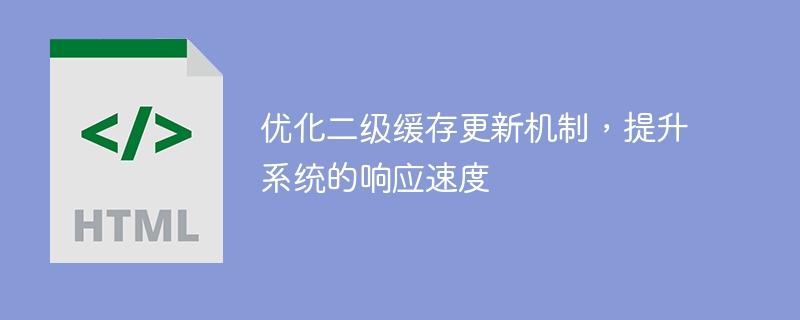

With the development of Internet technology, more and more systems and applications need to process large amounts of data. In order to improve the system's response speed and reduce data access time, developers often use caching mechanisms to optimize system performance. Among them, the second-level cache is a commonly used caching mechanism. It is located between the application and the database and is used to cache data obtained from accessing the database. This article aims to discuss how to optimize the update mechanism of the second-level cache to improve the response speed of the system.
In order to understand the update mechanism of the second-level cache, you first need to understand the basic workflow of the second-level cache. When an application needs to access data in the database, it first checks whether the required data exists in the cache. If it exists, the application will get the data directly from the cache, avoiding access to the database; if it does not exist, the application will read the data from the database and store it in the cache for next time use. When the data in the database changes, the cache needs to be updated to ensure that the data in the cache is consistent with the data in the database.
The update mechanism of the second-level cache usually has two methods: time-based update and event-based update.
The time-based update mechanism refers to setting an expiration time while caching data. When the data exceeds this expiration time, the cache will be marked as expired and the latest data will be retrieved from the database on the next access. This update mechanism is simple and easy to implement, and is suitable for scenarios where data changes are infrequent. However, when data changes frequently, excessive data updates may cause delays in cache updates, thus affecting the system's response speed.
The event-based update mechanism refers to notifying cache updates through the event triggering mechanism when the data in the database changes. When the data in the database changes, the corresponding event will be triggered to notify the cache of updates. This update mechanism can update the data in the cache in real time to ensure data consistency. However, a real-time update mechanism increases system overhead and may cause performance issues in high concurrency situations.
In order to improve the response speed of the system, we can take the following optimization measures:
To sum up, by optimizing the update mechanism of the second-level cache, the response speed of the system can be improved. Properly choose the cache update mechanism, update based on time and events, use incremental updates and reasonably set the cache expiration time, use distributed cache and other measures, which can effectively reduce the number of accesses to the database and reduce the cost of data transmission. Thereby improving system performance and user experience.
The above is the detailed content of Improve system response speed and optimize secondary cache update strategy. For more information, please follow other related articles on the PHP Chinese website!
 How to change word background color to white
How to change word background color to white
 Latest ranking of digital currency exchanges
Latest ranking of digital currency exchanges
 How to defend cloud servers against DDoS attacks
How to defend cloud servers against DDoS attacks
 The main function of the arithmetic unit in a microcomputer is to perform
The main function of the arithmetic unit in a microcomputer is to perform
 What to do if 302 found
What to do if 302 found
 How to set css dotted border
How to set css dotted border
 oracle insert usage
oracle insert usage
 Delete exif information
Delete exif information




